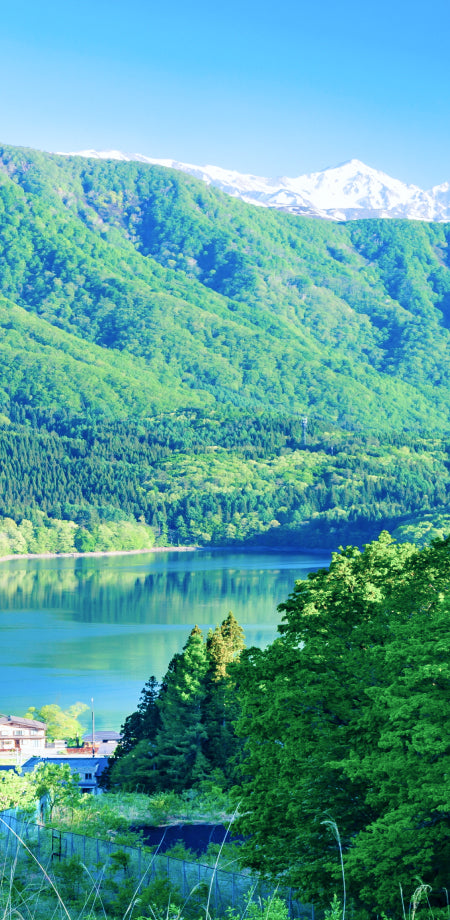投稿日:
更新日:
The harsh winter fosters ShinshuTraditional preserved food

In January and February, when the coldest times are the worstShinshu. Especially in basins and mountainous areas, most days are minus 10°C at night, and even within the day, the temperature is below 5°C. However, the cold was taken advantage of the opposite.Shinshupeople. We have made a variety of processed products using a natural freeze-dried method that is repeated, whereby the product is frozen at night and melted during the day.
Agar, kou and tofu are truly representative of this. Recently, it has attracted attention as a healthy food due to its excellent nutritional value. ThatShinshuHere are some traditional preserved foods that Japan is proud of, created in winter.
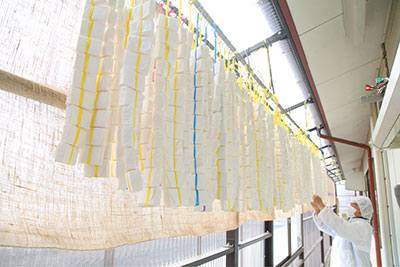
Easy to enjoy and convenient preserved food with excellent application
"Frozen Mochi" is packed with traditions made by hand during the harsh winter season
In the Warring States period, "Frozen Mochi" was also a source of siege when sieges were used as a source of food, and is a preserved food made by drying the rice cakes until they become crispy. It can be eaten just by putting it back in hot water, so it was apparently a useful snack in Iijima Town, a rice-growing area, as it was a snack between farming work.
People from Itsuwa have revived frozen rice cakes, which are now rarely made in Ina Valley.
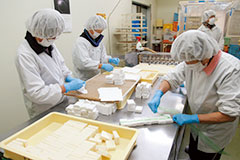
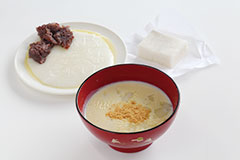
Work begins when the lowest temperature drops below freezing. Once the rice cake is left, soak it in water to soften it and pour it again with a pestle. The cubed rice cakes are wrapped by local mothers one by one in washi paper by hand, soaked in water for 2-3 days, then hang them under the eaves for about two months, and the rice is finished once the moisture has completely disappeared.
"When it was out of stock before, I tried making it in the summer, but it didn't dry out. But only the outside was dry and the inside didn't dry out. I realized firsthand that I can't make it unless it's winter," Hayashi smiled wryly. The frozen rice cakes are made from our proud rice cakes, and are filled with tradition and attention to detail.

Itsuwa Agricultural Association Corporation (Iijimacho)
Representative Director Hayashi Hidehiko
Established a union corporation in 2001. Using rice cakes grown locally, he produces a wide variety of products, including frozen rice cakes, daifuku mochi, and red rice, and sells them at local supermarkets and roadside stations. He loves cooking and is also focusing on inventing rice cake recipes.
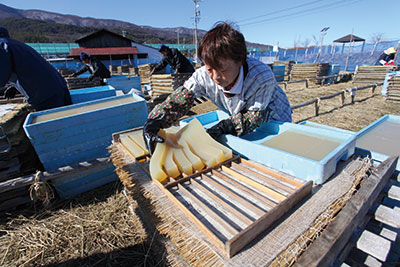
Natural freeze-dried food made in the winter sunlight and cold
Kaku Agar is the ultimate slow food created by the Suwa region environment
Kaku agar production began in the Suwa region, including Chino City, about 180 years ago. It is said that Kobayashi Kumezaemon, who was working in the Kansai region to produce agar, learned the manufacturing method and began making it in his hometown of Suwa.
To make horned agar using the natural method, not only does it require cold, but it also requires natural conditions such as high rates of sunny weather, low snow and wind, and good quality water. It is said that the Suwa region, which meets all of these, is the only production area in Japan.
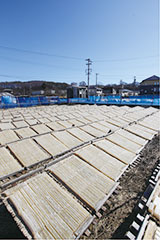
It can only be manufactured when temperatures drop between December and February. Due to the continued warm winter trend in recent years, it seems that the production is only about 70 days old.
"I really want to make horn agar beautiful. Just freezing it can bend and shape worse. Remove moisture from the daytime and freeze it at night. Repeating this process is the trick to making it beautiful and delicious," says President Ito. Kaku Agar is a luxurious slow food that can only be created in the environment of this region.
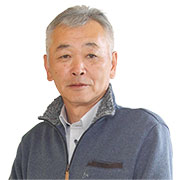
Kitahara Sangyo Co., Ltd. (Chino City)
President and CEO Ito Muneto
Founded as an Amakusa wholesaler in Edogawa Ward, Tokyo, in 1956, it moved its head office to Chino City and began manufacturing agar. After over 60 years of fertility, we currently manufacture about 500,000 square agar bottles per year, as well as thread agar and processed agar candy.
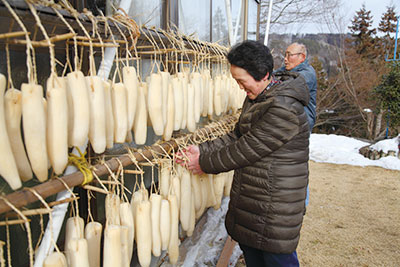
A preserved food packed with deliciousness, nutrition and happiness
The old-fashioned "frozen dried radish" that lives in the mountains
Nagano CityShinshuMiyao's family lives in a small village deep in the mountains of Shinmachi. His 85-year-old husband, Zenjiro, worked as a dairy farmer and a company, and now runs a farm with his wife, Masako.
At the Miyao family, it has long been common for them to cultivate soybeans, red beans, and vegetables in-house. In winter, I also work on making preserved foods such as frozen radish, just like working in the fields. "We just make our own crops we can eat even in the summer. It's a strange feeling to be told that we want them to sell them (laughs)," said Miyao and his wife laughing.

Although many dried fish are still available, the time-consuming "frozen dried radish" is a valuable ingredient and is also a popular product at direct sales outlets. It is a healthy food that is highly nutritious and when frozen radish is turned into a healthy food that contains more than 10 times more minerals, such as potassium, iron, and magnesium and dietary fiber than raw.ShinshuThere was also a secret to health and happiness in life in the mountains.

Miyao Zenjiro and Masako (Nagano City)
ShinshuA happy couple from Shinmachi. As Zenjiro says, "Our family has always been lively," he is the eldest of 12 siblings. I still live with a family of seven, my son, my wife and three grandchildren.















